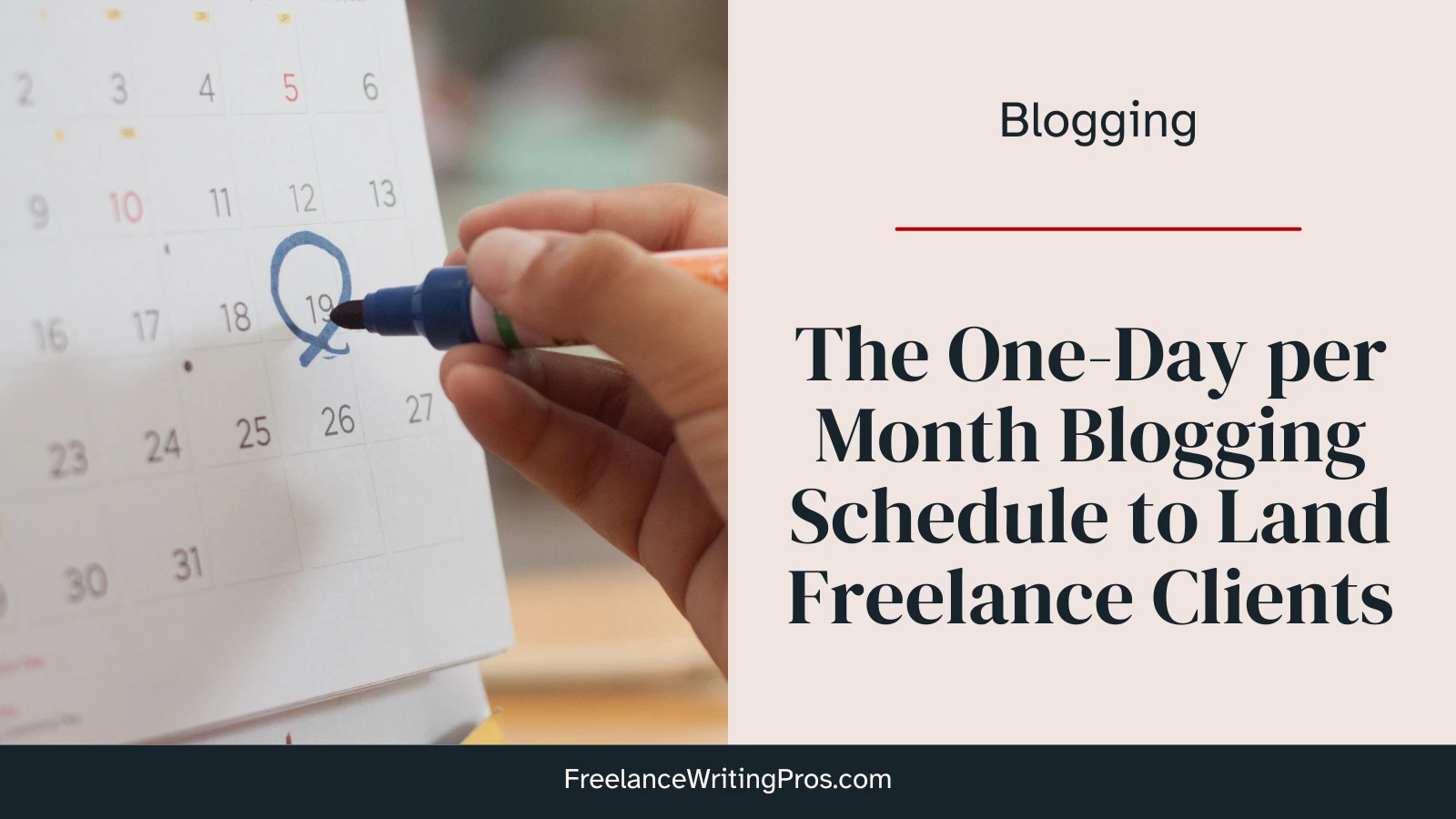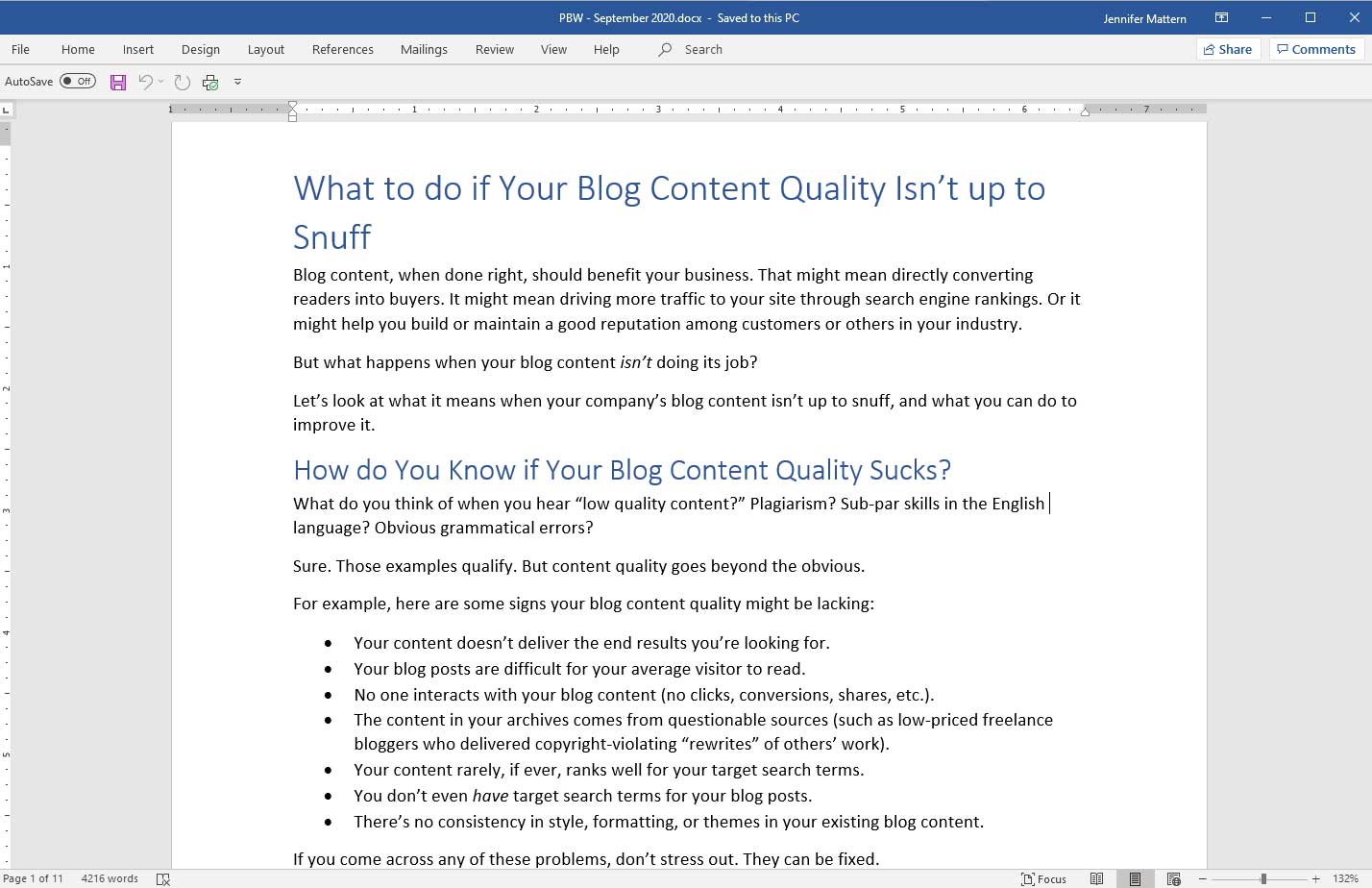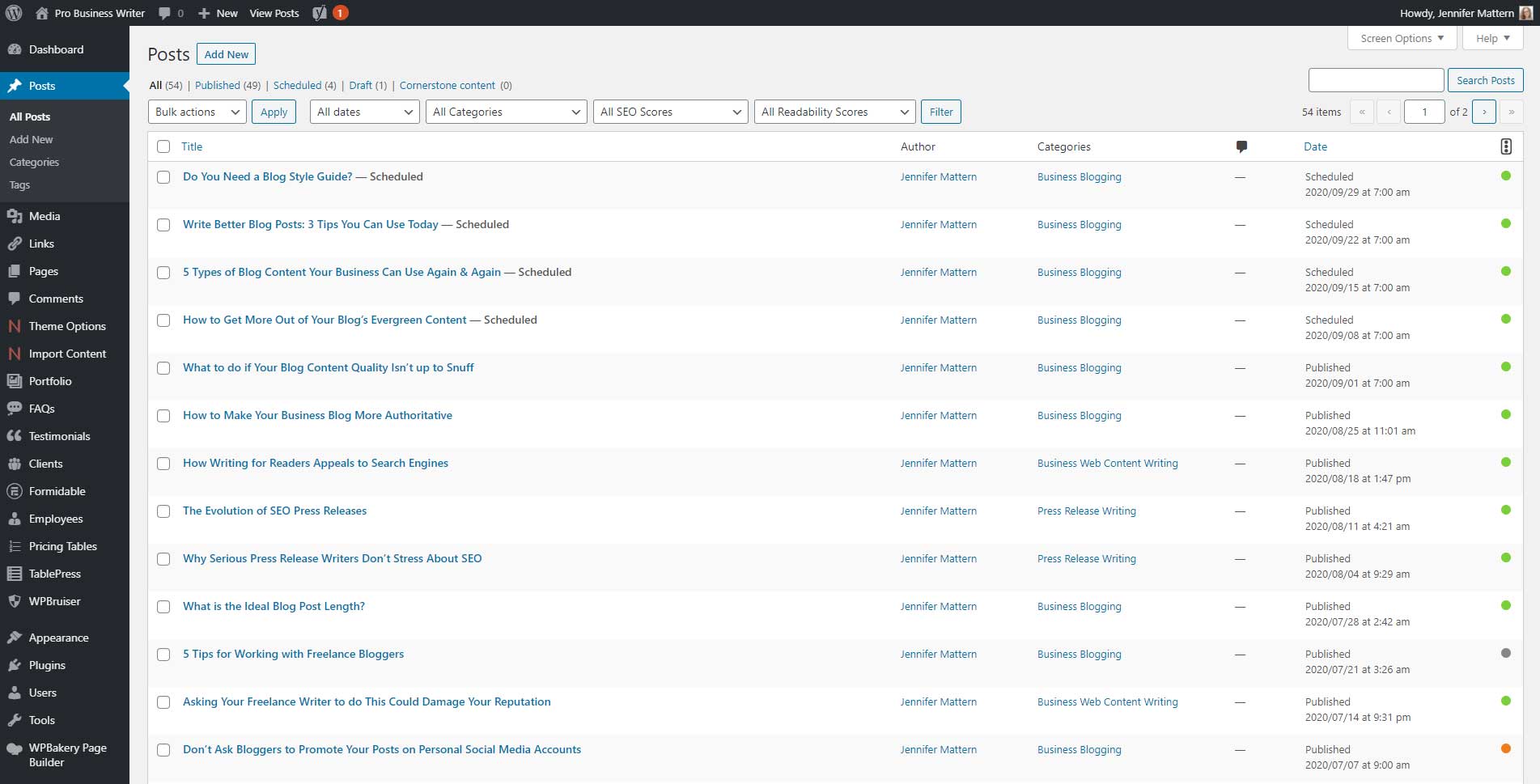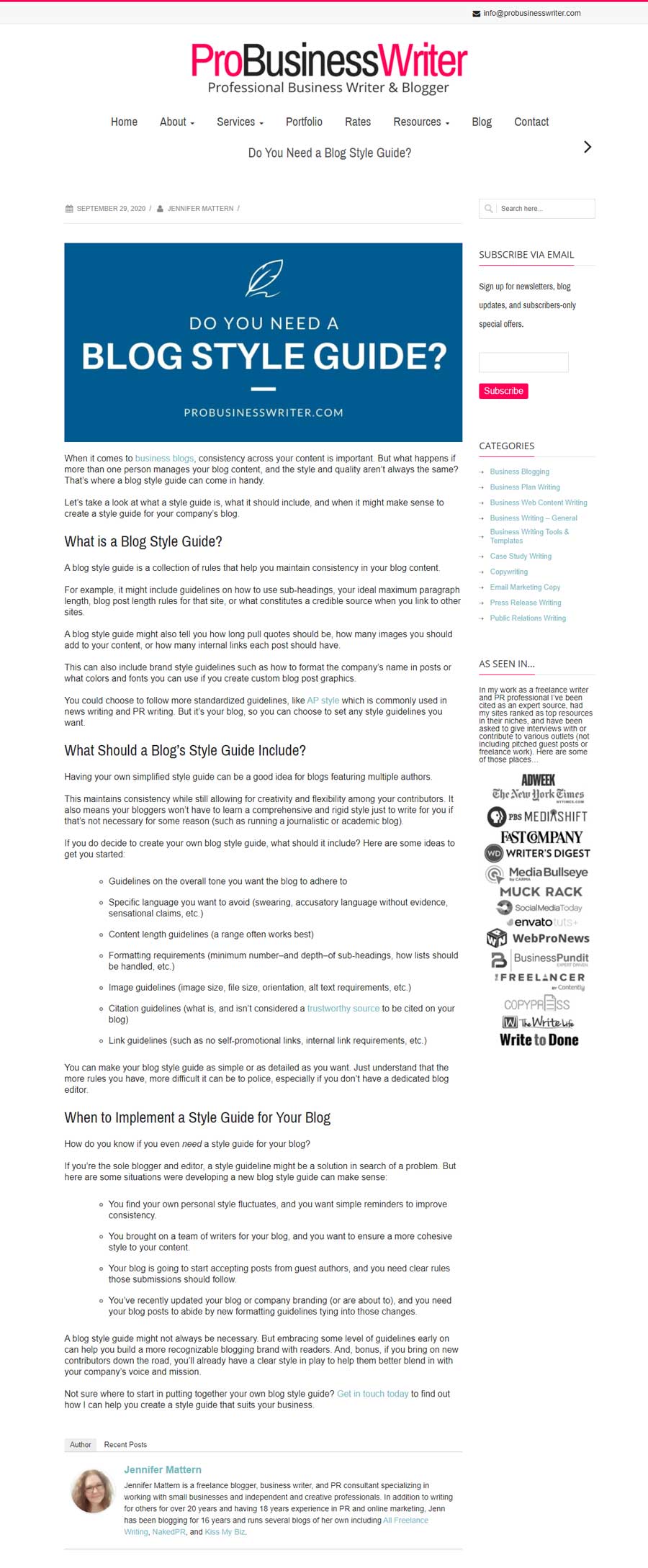
Over the years I haven’t exactly been subtle about the importance of blogging for freelance writers. But there’s one complaint I hear again and again: blogging takes too much time, so freelancers don’t want to put the effort in. But what if you could attract more clients with a simple one-day-per-month blogging schedule? Would that make it feel less daunting?
Today I’m going to share a method I use when I’m launching a new blog or I need to give a stale blog a bit of a kick. I devote one solid day to creating the base content for an entire month.
I’ll give you a breakdown of how long this took for my professional blog’s content in the past (as I’m cutting back on client work, I don’t often update that blog anymore), answer some questions you might have, and share the tools I used below.
“Blogging Takes Too Long…”
I hear this all the time from freelance writers:
“I don’t want to blog because blogging takes too long.”
Wrong.
Blogging takes exactly as long as you allow it to.
No one is going to stand over your shoulder dictating how many hours you need to spend on your professional site’s blog.
You could spend hours a day blogging if you wanted to. But that would be simply that — what you wanted to do (maybe to procrastinate from doing other work?). It’s not at all necessary to build an effective blog as a freelancer.
Forget everything you’ve learned about blogging.
To get over this misconception that blogging is some massively time-consuming endeavor, start by ignoring just about everything you’ve learned.
Have you learned about blogging from people who treat it as a business model?
Forget it. It doesn’t apply to you.
Have you learned about blogging from niche bloggers who focus on long-form content (and who love to tell people that’s the “right” way to blog)?
Forget it. It doesn’t apply to you.
Have you learned about blogging from SEO types who tend to focus on quantity and dominating as many search results pages as possible?
Forget it. It. Doesn’t. Apply. To. You.
Your professional blog isn’t your business model. It’s a support tool behind your service-oriented business.
Your professional blog isn’t the same as running a niche blog (or “publication” style blog). Again, it’s about supporting your services.
And your professional blog is not meant to dominate broad swaths of search results. It’s tailored to a very narrow area around your freelance writing services and specialty.
So all those things you learned that make you think blogging takes too long? Forget it. That information wasn’t written for you, and it has nothing to do with your blogging needs.
All it Takes is One Day per Month
The reality is writing content for your client-focused blog doesn’t have to take long at all. One day per month. That’s it.
You can write all the content you need for your professional blog by devoting just one day every month.
How?
Let’s start by looking at the work involved (it’s more than writing).
What to Include in Your One-Day-Per-Month Blogging Schedule
When setting up a one-day-per-month blogging schedule, these are tasks you’ll want to account for:
- Content planning
- Weekly blog posts (even one each month is better than nothing)
- Editing / proofreading
- Image search / creation / optimization
- Onsite SEO
- Scheduling
In other words, you have to decide what to publish, write that content, clean up your draft, take care of any images you might need, optimize your content a bit for search (make sure your target keyword phrases are there, use subheadings, include a meta title and meta description, etc.), then put the post in your blogging platform and schedule it.
And, yes, that can all be done in just one day. I promise.
My One-Day Blogging Schedule Breakdown
I decided to follow this strategy for my own freelance writer blog a while back as an example. Here’s what I did:
- I went with a weekly schedule, with posts scheduled every Tuesday starting the first of the month.
- This worked out to be five posts. In many months it would be four.
- I chose a single theme for blog content for the month — business blogging as it applies to the bulk of my clients.
- For simplicity’s sake, I used a single Word document, with a page break between posts. I did this because you can replicate it with any word processor. Scrivener would also work.
Here’s what the start of that Word document looked like. As you can see here, the five posts totaled a little over 4200 words, averaging a bit over 800 words per post.
Yours do not have to be this long. I tend to write thousands of words most days as it is, and I type quickly. If you struggle with speed for rough drafts, speech-to-text tools can help. Figure out how much you can draft in a day, and let that guide how many posts you write and how long they should be.
A benefit of using a single document for the month’s posts is that it leads to a relatively distraction-free process. You can move from post to post in the outlining and drafting process without having to shuffle through multiple documents.
My Time Breakdown
Here’s approximately how long each aspect of the work took:
- Choosing post topics (This was quick because I used to keep a running list of post ideas in Todoist. If you haven’t already done this, it’s a good use case for AI tools.): 15 min
- Outlines (I used my usual skeleton outline process, but also wrote the intros and CTAs for each post in this phase): 1.5 hours
- 5 Types of Blog Content Your Business Can Use Again and Again: 30 min
- Do You Need a Blog Style Guide?: 35 min
- What to do if Your Blog Content Quality Isn’t up to Snuff: 1 hour
- How to Get More Out of Your Blog’s Evergreen Content: 45 min
- Write Better Blog Posts: 3 Tips You Can Use Today: 30 min
- Revisions and optimization (also when I added them to WordPress and schedule them): 1 hour
- Images: 30 min
Overall, this month’s posts came to just over 6.5 hours.
And that’s about what I’d suggest aiming for, even if it means you only write one or two posts for the month.
Here’s a glimpse at these posts when they were scheduled on my professional blog. You’ll note the first one went live before I originally published this, and the others were scheduled every Tuesday of the month.
I don’t do a lot of direct marketing of my posts on this particular blog because I update it mostly for search visibility. But leave yourself a little extra time if you want to schedule social media updates around them, email newsletters, or any other kind of promotion. But again, not all months would have five weekly posts, so during many months this schedule would leave extra time anyway.
Questions You Might Have About the One-Day-Per-Month Blogging Schedule
I’m guessing you probably have some questions about the one-day-per-month blogging schedule proposed here, so I’ll do my best to anticipate and address them. Feel free to leave any other questions in the comment section below.
Are weekly blog posts really enough?
Absolutely. Again, this is something I’ve tested extensively over the years, specifically on a client-focused freelance writing blog. I’ve also worked with many solopreneurs as a consultant and freelance blogger, and I’ve seen similar results with them.
Your professional blog isn’t a publication in the sense that much larger blogs are (almost more like online magazines). It’s more in line with a newsletter, but with more public benefits.
Also, keep in mind your clients are probably busy people. They don’t necessarily have hours to spend every week reading a ton of new content on your blog. When you’re targeting decision-makers like business owners, managers, and editors, you need to respect their time.
This is a very different beast than writing a more general interest blog people read in their off-time. Make sure you have a good grasp on your target market and what kind of time they have before you commit to writing more posts than necessary.
Do I have to post every week?
A weekly schedule can work well because it doesn’t give readers a chance to forget about you in-between posts. But no. You don’t have to post every week.
If you can’t tackle 4-5 posts per month, try posting bi-weekly instead.
At a bare minimum, I’d recommend posting once per month if you’re using your professional blog for anything beyond search visibility.
If you use it mostly for that SEO boost, it depends how many leads are coming in. I tend to take breaks, then revisit it when rankings slip. But I have years of other promotion, links, etc. working for me. If your site is newer, you’ll need to post more regularly to maximize the potential of your blog.
Can I post more than once per week?
You can certainly post more often than weekly, especially iif short posts make the most sense for your client base.
While there’s no need to publish new blog content daily, if you have the time and energy to do that, there’s also no reason not to. Just make sure you don’t spend so much time blogging on your professional site that you don’t leave time for freelance projects.
Here’s another consideration: If you have time to write daily posts now, but you don’t know that you will a few months down the road, consider stockpiling content.
In other words, write the extra posts now if they’re evergreen in nature (they aren’t time-sensitive and won’t become outdated any time soon). Then schedule them several months out.
This is something I used to love doing — spend a solid week blogging, then I didn’t have to think about those blogs for months other than checking comments and basic promotion. It’s also a good way to batch content writing if you decide to build “quiet sites” for more passive income.
How long should my blog posts be if I have to write them all in one day?
When it comes to blog post length, there’s no one right answer. It depends on your blog, your audience, and the topics you’re writing about.
In general, a blog post should be however long it takes to tell a story or answer a question. And despite what you’ll read on blogs run by internet marketers, that does not mean you need to write posts running thousands of words each all the time (if ever).
Below you can see a screenshot for one of the scheduled posts I wrote for ProBusinessWriter.com as part of a single monthly blogging day.
As you can see, it’s not some epic post running thousands of words. It doesn’t have to be to address the post’s topic. And it shouldn’t be when appealing to my particular client base.
I find 800-1000 words is plenty given what those posts are designed to do. Some of my posts run a bit shorter, though I try to keep them over 500 words. And I aim to keep longer posts (like the one you’re reading right now) to a minimum on my client-focused site because I know what does, and doesn’t, work with that particular audience.
What if I can’t write blog posts quickly? How can I make the most of my blogging day?
I’ve been blogging for over 20 years now. I know my target clients well. And I tend to write about topics I know intimately on my professional site. Because of those things, I can turn around most blog posts quickly. If you’re in a similar place, that’s great! If not, that’s OK too. Your speed should improve over time.
If you can’t turn around 4 or 5 blog posts in a day, even short ones, then work with what you have. Adapt your blogging schedule to your current abilities.
Choose to post bi-weekly perhaps. Or even go with a single, longer monthly blog post if that’s how you need to start.
If you’re not new to blogging, another option is to turn to your archives.
Maybe write a couple of new posts, and then do quicker revisions of two older posts you think would still perform well. Re-publish the updated versions, inter-mixed with your new content.
Look. I know writers who like to say writing fast leads to sloppier work. That’s often because they happen to be slow writers themselves. Taking pride in it is easier than admitting they could improve.
That’s fine if it works for them. But slower writing doesn’t always equal better writing. Often, it’s just slower.
So don’t let those kinds of mental traps keep you from optimizing your blogging schedule. Embrace the quick, and sometimes dirty, draft. Then clean things up in editing. Opening yourself to a freer writing process can go a long way toward easing the sometimes-burden of blogging.
Why would I even want to do a month’s worth of blogging in a day?
Why wouldn’t you? When you knock out a month of blogging in a day, you:
- can spend more time promoting that content and other areas of your business;
- avoid missing weeks of content because your freelance load picked up;
- feel less pressure from your own routine deadlines each week;
- don’t put yourself under added stress to stay on top of things if you need to take sick time;
If I had the energy for it right now, I’d knock out six months of blogging at once and enjoy streamlining the rest of my workload for a while.
But if you don’t want to take on a one-day-per-month blogging schedule, that’s cool too. I’m just not sure why you’ve read this far. Pick a blogging schedule that works for you, and one that helps you meet your goals.
Contrary to popular belief, you don’t even have to blog consistently to see great results. It’s more about consistently sharing that content than it is about writing more. So if sporadic posting still achieves those goals, go for it. You do you.
Is there anything else I can do to make my client-focused blog posts more effective?
You bet!
If you want your professional blog to attract clients, you have to help it along. That content is almost useless if you don’t promote it in any way. After all, each post is an opportunity to bring new prospects to your broader site, which is (or should be) designed to convert them into paying clients. Because of that, you’ll want to make an effort to get more eyes on them.
What can you do to make your blog posts work harder for you? You can promote them as extensively as you want. But as an absolute minimum, here’s what I recommend:
- Share them on social media (especially places where you connect with prospects as opposed to family, friends, or other writers).
- Link to your new content from other properties if you have any (websites, other blogs, profiles on third party sites — anywhere appropriate and relevant).
- Submit the URLs to Google in your Search Console (which should be set up for every site you own).
For that last one, all you need to do is log into your Google Search Console, assuming you’ve set it up, and paste the URL (the full link) to your new blog posts in the “inspect any URL” field at the top of the page. Hit enter. Then click on “request indexing” on the right side of the page. Here’s what it looks like:

That’s all there is to it. One-day blogging is about having a plan, figuring out a system that works for you, then simply diving into the work.
If you’ve been hesitant to add a blog to your freelance writer website, or if you have a blog you’ve stopped updating due to the time commitment, I hope you’ll give the one-day-per-month blogging schedule a try. While I can’t guarantee this strategy will work for every blogger, or every blog, if you can make blogging work as a marketing and PR tool, you can reap cumulative benefits for years to come.
Note: This post was originally published on September 2, 2020, and it has since been updated.



